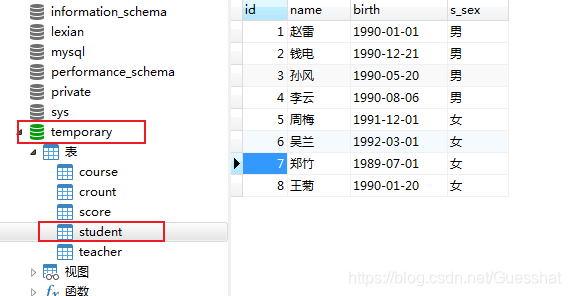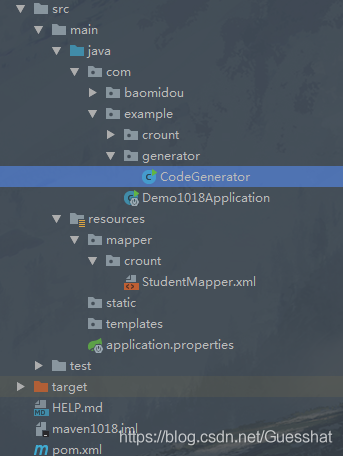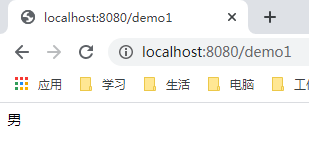SpringBoot下使用MyBatis-Puls代码生成器的方法
1.官方地址:
http://mybatis.plus/guide/generator.html#%E4%BD%BF%E7%94%A8%E6%95%99%E7%A8%8B
2.数据库结构:

3.依赖导入
<dependency>
<groupId>mysql</groupId>
<artifactId>mysql-connector-java</artifactId>
<scope>runtime</scope>
<version>5.1.39</version>
</dependency>
<dependency>
<groupId>com.baomidou</groupId>
<artifactId>mybatis-plus-boot-starter</artifactId>
<version>3.4.0</version>
</dependency>
<dependency>
<groupId>com.baomidou</groupId>
<artifactId>mybatis-plus-generator</artifactId>
<version>3.4.0</version>
</dependency>
<dependency>
<groupId>org.freemarker</groupId>
<artifactId>freemarker</artifactId>
<version>2.3.30</version>
</dependency>
<dependency>
<groupId>org.projectlombok</groupId>
<artifactId>lombok</artifactId>
<optional>true</optional>
</dependency>
配置freemarker是因为myBatis中默认的引擎是freemarker,支持自定义引擎
3.目录结构

4.官方生成器类
CodeGenerator
public class CodeGenerator {
/**
* <p>
* 读取控制台内容
* </p>
*/
public static String scanner(String tip) {
Scanner scanner = new Scanner(System.in);
StringBuilder help = new StringBuilder();
help.append("请输入" + tip + ":");
System.out.println(help.toString());
if (scanner.hasNext()) {
String ipt = scanner.next();
if (StringUtils.isNotBlank(ipt)) {
return ipt;
}
}
throw new MybatisPlusException("请输入正确的" + tip + "!");
}
public static void main(String[] args) {
// 代码生成器
AutoGenerator mpg = new AutoGenerator();
// 全局配置
GlobalConfig gc = new GlobalConfig();
String projectPath = System.getProperty("user.dir");
/**
* 这里需要设定一下保存的地址是本项目下的/src/main/java
*/
gc.setOutputDir(projectPath + "/maven1018/src/main/java");
gc.setAuthor("XYD");
gc.setOpen(false);
// gc.setSwagger2(true); 实体属性 Swagger2 注解
mpg.setGlobalConfig(gc);
// 数据源配置
/**
* 设置数据库名称和数据库账户密码
*/
DataSourceConfig dsc = new DataSourceConfig();
dsc.setUrl("jdbc:mysql://localhost:3306/temporary?useUnicode=true&useSSL=false&characterEncoding=utf8");
// dsc.setSchemaName("public");
dsc.setDriverName("com.mysql.jdbc.Driver");
dsc.setUsername("root");
dsc.setPassword("12345");
mpg.setDataSource(dsc);
// 包配置
/**
* 设置生成文件保存地址,模块名为命令窗口输入的模块名
*/
PackageConfig pc = new PackageConfig();
pc.setModuleName(scanner("模块名"));
pc.setParent("com.baomidou.ant");
mpg.setPackageInfo(pc);
// 自定义配置
InjectionConfig cfg = new InjectionConfig() {
@Override
public void initMap() {
// to do nothing
}
};
// 如果模板引擎是 freemarker
// String templatePath = "/templates/mapper.xml.ftl";
// 如果模板引擎是 velocity
// String templatePath = "/templates/mapper.xml.vm";
/**
* 这里定义的是生成xml文档的输出配置,存放在resource下
*/
// 自定义输出配置
// List<FileOutConfig> focList = new ArrayList<>();
// 自定义配置会被优先输出
// focList.add(new FileOutConfig(templatePath) {
// @Override
// public String outputFile(TableInfo tableInfo) {
// // 自定义输出文件名 , 如果你 Entity 设置了前后缀、此处注意 xml 的名称会跟着发生变化!!
// return projectPath + "/maven1018/src/main/resources/mapper/" + pc.getModuleName()
// + "/" + tableInfo.getEntityName() + "Mapper" + StringPool.DOT_XML;
// }
// });
/*
cfg.setFileCreate(new IFileCreate() {
@Override
public boolean isCreate(ConfigBuilder configBuilder, FileType fileType, String filePath) {
// 判断自定义文件夹是否需要创建
checkDir("调用默认方法创建的目录,自定义目录用");
if (fileType == FileType.MAPPER) {
// 已经生成 mapper 文件判断存在,不想重新生成返回 false
return !new File(filePath).exists();
}
// 允许生成模板文件
return true;
}
});
*/
// cfg.setFileOutConfigList(focList);
// mpg.setCfg(cfg);
// 配置模板
TemplateConfig templateConfig = new TemplateConfig();
// 配置自定义输出模板
//指定自定义模板路径,注意不要带上.ftl/.vm, 会根据使用的模板引擎自动识别
// templateConfig.setEntity("templates/entity2.java");
// templateConfig.setService();
// templateConfig.setController();
templateConfig.setXml(null);
mpg.setTemplate(templateConfig);
// 策略配置
StrategyConfig strategy = new StrategyConfig();
strategy.setNaming(NamingStrategy.underline_to_camel);
strategy.setColumnNaming(NamingStrategy.underline_to_camel);
// strategy.setSuperEntityClass("你自己的父类实体,没有就不用设置!");
strategy.setEntityLombokModel(true);
strategy.setRestControllerStyle(true);
// 公共父类
// strategy.setSuperControllerClass("你自己的父类控制器,没有就不用设置!");
// 写于父类中的公共字段
// strategy.setSuperEntityColumns("id"); //注释这行否则生成的实体类中没有Id变量
strategy.setInclude(scanner("表名,多个英文逗号分割").split(","));
strategy.setControllerMappingHyphenStyle(true);
strategy.setTablePrefix(pc.getModuleName() + "_");
mpg.setStrategy(strategy);
mpg.setTemplateEngine(new FreemarkerTemplateEngine());
mpg.execute();
}
}
5. 代码生成后的配置
- 默认生成的代码中实体类是没有id属性的,在代码生成类中注释掉
strategy.setSuperEntityColumns("id"); - 默认生成的mapper对象上是没有@Mapper注解,需要在主配置类中加入@MapperScan注解,进行mapper扫描
@SpringBootApplication
@MapperScan("com.example.crount.mapper")
public class Demo1018Application {
public static void main(String[] args) {
SpringApplication.run(Demo1018Application.class, args);
}
}
另外自己要运行代码进行数据库访问,所以application.properties中也要配置数据源
# 数据库配置 spring.datasource.url=jdbc:mysql:///temporary?characterEncoding=utf-8&useSSL=false spring.datasource.driver-class-name=com.mysql.jdbc.Driver spring.datasource.username=root spring.datasource.password=12345 #连接池配置 #spring.datasource.type=com.alibaba.druid.pool.DruidDataSource
6.controller开发
注入service,修改访问的地址,写入访问的方法
@RestController
public class StudentController {
@Autowired
private IStudentService studentService;
@GetMapping("/demo1")
public String m1(){
Student student = studentService.getById(3);
return student.getSSex();
}
}
7.生成的代码放到主配置类的同级目录下,运行代码

到此这篇关于SpringBoot下使用MyBatis-Puls代码生成器的方法的文章就介绍到这了,更多相关MyBatis-Puls代码生成器内容请搜索我们以前的文章或继续浏览下面的相关文章希望大家以后多多支持我们!
赞 (0)

